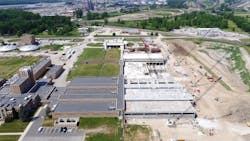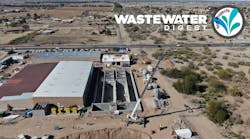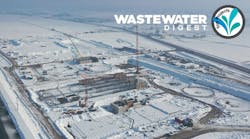Cost: $70,638,000
Location: Toledo, Ohio
Year: 2021-12-21
Size: 40 mgd
Owner: Toledo, Ohio
Designers: Arcadis
Black & Veatch
Vision Design Group
Dmytryka Jacobs Engineers Inc.
Contractor: Mosser Construction
Colgan-Davis
Mondo Mechanical
In October, 2011 a 20-Year Master Plan and Needs Assessment was completed for the Toledo Collins Park Water Treatment Plant, located in Toledo, Ohio.
This document identified approximately $250 million in needed improvements, which included increased plant capacity and redundant capacity to allow maintenance work on the treatment basins and to allow the existing treatment basins to be taken out of service for major renovations. The Master Plan was shared with the Ohio EPA to assist the city with improving its water treatment facilities.
In July 2014, Arcadis was approved for preparation of a general plan for capacity improvements, the Basin No. 7 and Basin No. 8 Improvements project. One month later, Toledo issued a “Do Not Drink” order to its customers due to the presence of microcystin, a harmful algal bloom toxin, in the finished water from the treatment plant. Lake Erie, the source of water for Toledo, was experiencing a harmful algal bloom, which produced the toxin.
The project had several goals, first of which was to provide additional 20 mgd capacity to meet the projected maximum day demand of 133 mgd for a total rated capacity of 140 mgd. Another goal was to improve filter operations by using a granular activated carbon (GAC) filter media to promote biologically active filtration (BAF) and air scour to improve backwashing.
Long term improvements to tackle this issue recommended by the general plan include the installation of an ozone treatment system for which accommodations needed to be made as part of the project. In Nov. 2015, the Ohio EPA identified the Basin No. 7 and 8 improvements as a “significant deficiency” with a negotiated deadline for completion of Apr. 2020.
The completion dates for the capital improvements projects negotiated with the Ohio EPA required that multiple projects would need to be underway concurrently. With multiple projects, design professionals, and contractors, the city utilized a professional construction management team to help coordination between projects, perform administrative responsibilities and provide resident project representation.
A “Special Plant Accommodation” form was used to keep plant staff informed of construction work that would impact operation and maintenance activities and to coordinate construction work with other construction projects.
The expansion of the treatment plant to the east required relocating the western embankment of a residual solids storage lagoon, Lagoon E, to provide sufficient room for buried utilities and an access roadway. This relocation required the removal of stored solids in the lagoon under a separate contract. Weather issues delayed the solids removal process, which in turn delayed the relocation of the embankment. In addition to this delay, during reconstruction, an embankment slope failure occurred, which further delayed the effort to allow for coordination with the Ohio Department of Natural Resources and redesign of the embankment.
The design of the southern portion of the new facilities included the need for pre-loading of the existing soils to obtain the necessary soil bearing capacity. Due to uncertainties of the time needed to achieve this capacity, the contractor proposed a change to auger cast piles for foundation support, which was accepted by the city.
Although the improvements are an extension to the existing treatment facilities that are within a fenced and secured area, there was a concern that the security of the site would be compromised, and existing roadways would becomoe overloaded due to the significant construction and delivery vehicle traffic. To handle these concerns, a fenced construction area separate from the treatment facilities was established for the duration of the project, including a separate temporary construction entrance with a security station.
The completion of the project has now provided the treatment capacity and has allowed the city to take existing treatment Basins 5 and 6 (with filters 21 through 30) out of service for needed structural and mechanical renovations and filter rebuilding. This will be followed by renovations of treatment Basins 3 and 4 (with filters 11 through 20), and then Basins 1 and 2 (with filters 1 through 10).
Each of these projects will renovate 40 mgd of treatment capacity while maintaining 120 mgd of treatment capacity to serve the city’s customers.
The building additions were also designed to be architecturally compatible with existing facilities’ industrial art deco from the 1940s and 1950s. The project was completed Mar. 31, 2021.
Project Year: 2021-12-21Contractor: Mosser Construction Colgan-Davis Mondo MechanicalDesigners: Arcadis Black & Veatch Vision Design Group Dmytryka Jacobs Engineers Inc.Owner: Toledo, OhioLocation: Toledo, OhioCost: $70,638,000Size: 40 mgd

